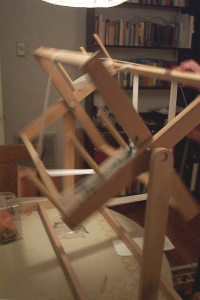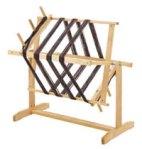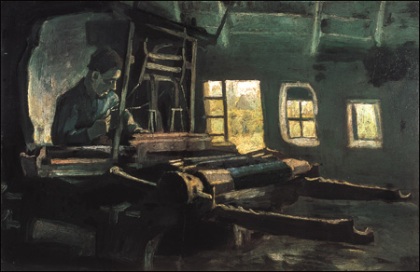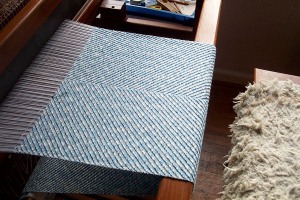The Teacup or the Stick
May 30, 2008
Tea is a great motivator because it can be either the reward for finishing a task, or the reward for starting it. For example, you can tell yourself, “When I’m finished winding these spools, I’ll sit down with a cup of tea.” I prefer to say, “I’ll have a cup of tea while I take care of these spools.” Once I have put the reward in motion–put the kettle on, that is–I can’t back out. Resolve stated, tea in hand, I would feel silly just plopping down in front of the computer. Isn’t it just as as easy to wind spools as futz around on the computer while I’m drinking a cup of tea?
I became allergic to coffee about 6 years ago, but it was never something I drank regularly. As a caffeine delivery system it was just too harsh for me. Black tea generally has about 1/3 the caffeine of coffee.
I can drink tea while winding spools, threading, sleying, or drafting–anything I can take my hands away from long enough to reach for my cup. I’m careful, but I know the day will come when I knock my tea over on some yarn. Perish the thought. I do try to keep my tea in a separate part of the room from any yarn activities. It serves the further purpose of making me get up to stretch my back and arms.
But never mind that. The real reason you are reading this post is because it will guide you to a wonderful website!
I found it when I was checking out my idiom for the title. “The carrot or the stick” sounded right, but I wasn’t sure. As Mr. Brians puts it,
The debate has been confused from time to time by imagining one stick from which the carrot is dangled and another kept in reserve as a whip; but I imagine that the original image in the minds of those who developed this expression was a donkey or mule laden with cargo rather than being ridden, with its master alternately holding a carrot in front of the animal’s nose (by hand, not on a stick) and threatening it with a switch. Two sticks are too many to make for a neat expression.
My first thought when I looked over his list of errors was, “I am so glad I am not a literature professor!” You know he must have found all these while he was reading student essays. Some of my favorites are missing (that/who), but what a list!
I’m not the old guard. I have a particular dislike for popular pet-peevish grammar and punctuation books. Yes, I have my preferences, and some of them are uppity (“different than” makes my skin crawl, though many sources allow it) but the blood of the language crusader has never thrummed in my veins. I do not pencil corrections in books. I like to think I stand with the more easy-going linguists. Everyone has a right to his own like, verbal peccadillos.
But!
Written language is a bit different, and some of these misuses are so bad they’re funny. What surprises me is how illogical they can be. When a common saying remains in use but loses its original referent, that seems okay to me, because the referent has usually been replaced in people’s minds with a more up-to-date picture. (Or maybe the saying remains beautiful simply for the curiosity it inspires when you pick it up and look at it more closely: a language fossil.) But when a pithy metaphor becomes actual nonsense. . .
I like it that Mr. Brians doesn’t object to the carrot on the stick because it is a newer image, but because the extra stick clutters the expression: no longer simply x or y, but x and y, or y–where x is carrot and y is stick.
I laughed, I cringed, and . . . I found a few of my own mistakes. The Ukraine. Dove/dived (I still like dove). Careen/career (I thought careening could mean careering, too). Farther/further. Access (stubborn about that one too. I’m pro verb).
I also like it that he admits there’s no right choice sometimes:
“Macabre” is a French-derived word which in its original language has the final “ruh” sound lightly pronounced. Those who know this are likely to scorn those who pronounce the word “muh-COB.” But this latter pronunciation is very popular and blessed by some American dictionaries, and those who prefer it sometimes view the French-derived pronunciation as pretentious. It’s up to you whether you want to risk being considered ignorant or snooty.
To wind this up, I would like to propose (what I think may be) a meme. If you’re reading this and enjoy thinking about these sorta things, you’re tagged.
What expression or lyric did you mishear or misunderstand as a child?
I was about eleven before I realized there was more to this nonsense song than met the ear:
Mairsey dotes and dozy dotes
and little lambs e-divey.
Kiddle e-divey do,
Woudn’t you?
Allow Me a Whine
May 30, 2008
Warping reel put away. 314 threads of lovely 28/2 merino. I shouldn’t be complaining.
But, Waaaaaa!
Make that 313 threads. As I was about to put away the chained warp away I found a broken thread, right in the middle of the 7 yard warp. After 3+ hours on my feet by the reel, I might not have been thinking very well. Instead of starting (our late) dinner, I decided to sit down and extricate the single thread from the chain, it so offended me. A broken warp thread while I’m weaving, I can deal with. For some reason, a broken thread between the reel and the chained warp just makes me sad. I think I may have dragged it across my scissors, which I left on the table under the reel as I was chaining off the warp.
Now I’m having a Madeira, and der Mann is out buying fresh tortillas for us to eat with leftover chicken. Thank you everyone for your advice. I’d like to talk more later about some of the issues your comments brought up.
Warping Reels and Beaming
May 23, 2008
I have a confession to make. Even though I am looking forward to working with some color at the end of my warp, I have been dawdling about getting there. I don’t really want to be finished, because that means it’s time to get out the warping reel and get frustrated.
Part of my problem is that I have not found a satisfactory way to beam on. My old weaving books show Swedish högskola girls in 1940’s wedge sandals and handwoven aprons working in teams of four. If I had some Swedish high school students I’d use them! My husband helped me with the last warp, and it was not good for our relationship. He turned the warp beam while I tried to hold one half of the warp in each hand, put in sticks, shake the threads, and give orders at the same time: “Stop. No, go back one notch Okay. No. Wait! Okay, now. Nooooo!”
It doesn’t help matters that my warping reel makes one side of the warp ever-so-slightly longer than the other as it climbs the pegs. I have to compensate for the lopsided tension by combing it as I beam.
I’d like a better reel, but I’m afraid the tension problem is endemic to them. My current reel is similar to the Louet yarn-blocker/warping reel. It lacks those separate cross-pieces that carry the pegs on Schacht and most other horizontal reels.
It lacks those separate cross-pieces that carry the pegs on Schacht and most other horizontal reels.
Yet even with better-positioned pegs, isn’t there is always going to be a tension discrepancy as the plane of the wound warp transfers from the horizontal barrel of the reel to the perpendicularity of the pegs?
Any fellow reelers out there? I would love to hear your take on this problem. What sort of reel do you use? Can you wind an evenly tensioned warp with it?
As for the beaming, I beamed my first few warps by myself when I was warping Swedish-style. (That’s the back-to-front threading method where you sley the reed twice, using it as a raddle the first time). The tension wasn’t too bad, and frankly I can’t remember how I managed it! I was using 15-dent reed, so that might have helped–the friction as the yarn pulled through.
But then I bought a bendy quarter-inch Glimåkra raddle. I tried it on both the front and the back beams with poor results and some bad ol’ times with my beaming partner. Fortunately, they were forgiving warps. (Fortunately, I have a forgiving spouse.)
I’m about to wind a new warp. It’s fine wool–not too wide, but long. And you know, I’m afraid the original owner of my loom was right. In a handwritten note with her warping instructions, Mrs. S-G declared to her granddaughter, “This is the way I warped a loom. . .This is the simplest and best way to warp no matter what anyone says about it. I can put a 45” warp on a loom with no one helping, which I preferred to do.”
So I’ve given in. My loom is Swedish. Designed by a Swede, built by Swedes. Okay! I’ll dress it like a Swede, for Pete’s sake! I’ll follow your directions to the letter Mrs. S-G. Unfortunately you don’t say how you kept your tension.
On Bergman looms the main warp beam rests in the castle, a little higher up than the back beam. If I’d thought logically about this fact, I’d have known a raddle wasn’t the way to go. But I wasn’t thinking logically. I was thinking that I didn’t want to sley the whole warp twice. After struggling to lay my warps in an open raddle without accidentally lifting a piece of them out again or knocking the rod out of the loops and onto the floor, I’m not going to mind the extra sleying so much. I now have a rocking chair with arms that are perfect for propping a reed across my lap. And great plans for some bag clips from IKEA.
The tension problem remains. I don’t have enough floor to drag the warp across it under weights as Elkhorn Mountain Weaving recommends. I don’t have a warping trapeze like the Vävstuga folks. If I were a homeowner, I would hang chains from the ceiling and suspend my warps over a wooden closet-rod. For now I guess I’ll try the milk jug trick. It’s just that my beam is so low, I’ll be rehooking them every 12 inches.
Advice is welcome! Wish me luck.
Getaway
May 22, 2008
or, How it Happened, conclusion
Picture yourself driving on the highway on a calm night in early November of 2006. A minivan speeds up alongside you. Perhaps the van’s faulty rear dome light is still on, revealing a strange bulk of varnished wood. What are those people hauling? Is it some kind of salvaged cabinetry? It certainly looks old; it’s that old fir the color of buckwheat honey. There are funny long sticks hanging off it though, bundled with cords. Then you catch a glimpse of a wooden lever. Could that be . . . a loom?
The Craig’s list ad was less than a day old when my husband spotted it. I phoned immediately, but I was already one of many callers. A guy traveling abroad had begged her to hold it for him until he got back, and a pair of ladies had come to look at it that very afternoon.
“Oh shoot,” I thought. “I’m too late. She’s just waiting for them to come back with the money.”
The funny thing was that the seller still wanted to talk with me about her loom, especially after I told her how beautiful I thought it was. She told me it had belonged to her weaving-teacher grandmother. Then she said some more about the weavers who had come by that afternoon. Their only reluctance had been about the price, since the joints “might need work.”
So, why was this lady willing to spend fifteen minutes telling me about her grandmother’s loom when I was only a standby? I would have thought it was a hard sell, but that didn’t make sense with the number of calls she was getting. And if it were a hard sell she certainly wouldn’t be telling me a professional weaver had been shoving her loom around and finding it wanting in the joints!
And yet the first thing she’d said to me was, “I’d really like to sell it for the full price.”
I’m a bit dim. Suddenly it clicked: this woman hadn’t just been talking about the money, she’d been talking about wanting someone to value her grandmother’s loom as much as she did. She wanted them to know what they were getting, and to see immediately that it was worth the price she’d set!
“I know you have to be fair and first come, first serve, and all,” I said, “But could I possibly see it, just in case?”
Der Mann and I left as soon as we had bolted some dinner and filled up the gas tank. It took about two hours to get down to the city, where we found ourselves in a neighborhood of lovely early 20th century walk-up apartment buildings. Wow. We had been apartment hunting just a year ago, so I knew the market. I couldn’t even imagine the rent on a place like this.
The lady who answered the door was in a mild tizzy. Her grandmother had given her the loom when she was a young woman in the 1970’s. In fact, she had given each of her grandchildren a loom from her weaving school, but the others had sold theirs years ago. It was a guilt-loom. A beloved guilt-loom. We found out the loom lady worked in the arts sector, and had always meant to weave again. (Since weaving rya in the 70’s, she hadn’t really.) Now she figured her beaded jewelry was enough of a creative outlet. Selling the loom was her first step toward downsizing for a move. Her niece was there for moral support. The atmosphere was tense and hurried.
Extreme tact was required.
I didn’t have to pretend to love the loom. In fact, I was trembling with excitement as soon as I saw it. It was in beautiful condition. The loom lady pushed heavily on it a couple of times to show me the play in the joints–which was minimal, and only affected the side-to-side axis, not front-to-back. “It’s fine as long as people don’t keep pushing on it all day!” I didn’t say. In my head it was already mine.
I suspect the hurriedness and tenseness was because now that she’d started process of loom-excision, she wanted to finish it quickly, like ripping off a band-aid. It was just my great luck that clearly she wanted to sell her loom to ME. NOW. I slowed myself down to check carefully for all the components. They were all there . . . and then some. What was that extra ratcheted beam in the castle? An extra warp beam? It must be.
Everything was very orderly. She had even counted up all the string heddles and bagged them in labeled groups. It was sad in a way–as if I would be hauling off not just her grandmother’s loom but her actual grandmother, and she wanted to make sure the old lady had packed her toothbrush and plenty of hankies. Yes, loom lady, I’ll take good care of granny! I hope she could tell.
We went back to the kitchen. Der Mann had gotten as much cash as the ATM allowed, and I was writing a check for the rest. About five large plastic storage boxes of yarn and unidentified wooden objects were sitting on the dining room table.
“For another $100 you can have all the yarn and shuttles and things if you like.”
I don’t know if she had even been planning to sell them until that moment. It might have been a last minute kindness, or a last minute clean sweep. Can you faint from bliss? There was also a box of books I didn’t even have time to look at, and an umbrella swift in pieces. The swift was the piéce de résistance: she said it had been her grandmother’s grandmother’s swift in Sweden, which meant it was probably at least 150 years old. All it needed was restringing. I didn’t count the shuttles but there were a lot.
The loom lady said she had spun and dyed some of the wool with her grandmother, who had also raised sheep. Then she lifted up a huge jar stuffed with scraps of cloth and pushed them them away from the rest of the stuff. “Oh, and these are just her samples of things she wove. You wouldn’t want them. They wouldn’t mean anything to you.”
I so wanted to snatch up the jar saying, “YES! I WOULD!” I glimpsed all kinds of fine linens through the sides of the jar. Sweet little rosepath borders. Wool suitings. But I already had an embarrassment of riches, and the fraught emotional atmosphere demanded my restraint. It still drives me a little crazy though; I couldn’t tell if she really wanted to keep the samples, or if she really just thought they were were worthless, given they had been treated that way, stuffed willy-nilly in that old jar. Maybe she didn’t know it’s possible to find out how to weave something just from looking at it?
Anyway, if I’d said I wanted the samples, I was afraid it would all disappear, as if I were the greedy man in a fairy tale who asks the magical being for just one thing too many. “What! You’d take my grandmother’s samples? Well then you’ll have no loom!”
Amid the tying up and dismantling and reciept making and minivan loading I learned some more of its history.
Margaret Bergman, a Swedish farmwife on the Puget Sound, began teaching local women to weave in the late 1920’s. She designed, patented, and had her family begin manufacturing a clever folding countermarche so her students could have their own looms. One of her students was the loom lady’s grandmother, Mrs. S-G. Mrs. S-G also took a textile course at the University, and started her own weaving school in turn on Lake Sammamish in the 1930’s or ’40’s. Loom Lady was very proud to tell me that Jack Lenor Larsen (at the time I had never heard of him!) had learned to weave on this very loom; apparently when he was at the U of W he went out to Mrs. S-G’s place for lessons. All of the 8? 10? looms she eventually acquired for her school were ordered from her old teacher Margaret Bergman–she believed there was no better loom.
When Mrs. S-G was past running a weaving school she broke up her studio. The loom lady was her only grandchild who had wanted to weave. When the young loom lady moved to San Francisco in the 1970’s, her dad made a special packing crate to ship her the loom.
My loom went to San Francisco with the flower children.
And came back North to it’s home town again, part of the general migration.
There wasn’t room for the custom packing crate in the car, so we’d have to make another trip for that. It started to rain. It was about 11 when we got home, but I didn’t want to wait to unload. We carried everything inside. When we were done I crawled around the living room with a towel, drying every side of every piece of wood to make sure I hadn’t missed any of the raindrops. It felt like we’d just completed a heist, and I had gotten away with something both terrifying and amazing.
My Husband’s Hair
May 18, 2008
This morning I cut my husband’s hair. It always goes just a little too long before the planets align, and I have the energy and he has the sit-still-able-ness to make it happen. Today I got up early and was weaving and well awake, then he got up and was groggy, and I cornered him (in a nice way.)
When we first met he had golden ringlets. Over the years the curl has relaxed and his hair has grown darker and finer, but it still has just enough oomph to be nearly impossible to cut. Basically, there are all these tufts that insist on flying out into space in goofy opposing swoops. It’s a struggle to try to cut it long enough to allow the curls to make a full circuit back toward his head (they never do, really), but not so long it sticks out in a sort of 50’s women’s short wavy haircut shelf over his ears, which is quite unbecoming on most people.
Sometimes I get frustrated with the effort. I asked him to try going to a trendy stylist once and a barber more recently. Both times, he came back with a much worse haircut than the ones I give him. The fact of the matter is that after cutting his hair since college, when it was more like shearing a sheep, no one knows my husband’s hair as well as I do. Today it took less time than ever, and I was pleased with the results. I’ve finally discovered the right method: a particular arrangement of clips to hold the top layer out of my way, and working front to back. As I was finishing up I said, “There. Now you look like that guy on Galactica who married the Cylon. His head is square and narrow too.”
Today it took less time than ever, and I was pleased with the results. I’ve finally discovered the right method: a particular arrangement of clips to hold the top layer out of my way, and working front to back. As I was finishing up I said, “There. Now you look like that guy on Galactica who married the Cylon. His head is square and narrow too.”
“Square and narrow?”
“Yes.” I said definitely.
Later I realized that “square and narrow” doesn’t sound that great as a description for the part of your body that holds your brain.
Little Big Loom
May 15, 2008
or, How it Happened, Part III
Toward the end of my class, it struck me: I would soon be loomless! Just when I had discovered weaving yarn on eBay!
I did a lot of research and checked around the internet, where I found a nice page of advice for new weavers that offered several good reasons for starting out with a floor loom rather than a table loom. When I started checking prices, it seemed that a decent 8-shaft table loom was so expensive, I might as well look for a floor loom: they were both so far out of my price range. And as long as I was looking for a mythical loom, why not look for the kind I wanted?
I wanted a countermarche.
The decision-making process went something like this: Van Gogh. Andrew Carnegie. Wood. Sweden. My perversity. Tension.
First, I had somehow got these images in my head, and others like them:
I didn’t have any rosy ideas about 19th century textile production. These particular weavers were miserable folk! But I did like the way they looked at their looms. I liked to think of a time when handweaving was still a viable form of industry, as when . . .
 . . . Andrew Carnegie was a boy. Barely. He was born at the end of that era. My favorite 19th century philanthropist emigrated when he was 13; his father was an agitator against the mills that were already destroying his livelihood as a handweaver. I saw their narrow house in Dunfermline, Scotland. Next door is a “Carnegie Museum” chock full of the awards he was so fond of receiving for his generosity–the man was a monumental egotist!–and not much else. It was fascinating: I could see the course of his life in the contrast between the cramped little room where his father worked, and the praise-hungry steel magnate’s museum. The huge drive that propelled him from one to the other. It was like the story of the transition to the modern era in miniature.
. . . Andrew Carnegie was a boy. Barely. He was born at the end of that era. My favorite 19th century philanthropist emigrated when he was 13; his father was an agitator against the mills that were already destroying his livelihood as a handweaver. I saw their narrow house in Dunfermline, Scotland. Next door is a “Carnegie Museum” chock full of the awards he was so fond of receiving for his generosity–the man was a monumental egotist!–and not much else. It was fascinating: I could see the course of his life in the contrast between the cramped little room where his father worked, and the praise-hungry steel magnate’s museum. The huge drive that propelled him from one to the other. It was like the story of the transition to the modern era in miniature.
What really got me, though, was the hole in the ceiling. Mrs. Carnegie would sit in the upstairs room winding bobbins, which she tossed to her husband through a hole in the floor. The weaving room was empty, no loom or anything else, but the hole in the ceiling was still there. It was so easy to imagine the rest.
Neither Van Gogh’s miserable dagloners nor William Carnegie probably used countermarch looms. Counterbalance and draw looms? But this brings me to the third facet of my decision-making process. Their looms were huge. I was greedy for wood.
Wood! I wanted a loom with as much wood as possible, preferably a tree’s worth or two. Big. Stable, unlike our living situation and finances. Too big for our rental! Too big for any house we were ever likely to own! In fact, what I really wanted was a loom I could convert into a house if necessary. This was impossible, so I decided to go for the same kind of loom as the biggest looms currently available, which are countermarches.
Incidentally, I’m a Svenskaphile. I love the cohesive aesthetic I found in Sweden. A Swedish-style loom sounded just dandy, and when I started understanding the countermarche system a little better, I thought it might suit me in other ways as well. It is more time-consuming to tie up countermarche treadles (perversity), and it produces a cloth that is more uniform on both faces (tension).
The tension thing–with the shafts pulling the warp both up and down, so that none of the threads get stretched out any more than the others–said “better cloth” to me. Now, I doubt it. But I am a sucker for the idea of consistency and quality, and of having to go to more trouble to produce better results. Plus I really liked the way the words “wider sheds” kept coming up. “Yeah, those big sheds! Bring ’em on!” (Please take note for purposes of future irony.)
Does anyone remember checking the housecleaning pages and guild ads during their own loom search? All those beautiful, well-kept (too big) looms on the other side of the country? Or in some cases, in another country? I found an old Cranbrook used by nuns in the midwest, and a gorgeous hand-made Glimåkra look-alike (“pick-up only!”) on an island. The fact that everything cost three times as much as I could afford did a lot to temper my disappointment.
The nearest I came was a Louet, but I just couldn’t do it. Somebody else bought it before I could change my mind and beggar us.
I set my sights back on a table loom. No luck. Weavers don’t get rid of their 8-shaft table looms! Again, I adjusted my expectations. I was about to bid on a 4-shaft Woolhouse Tools table loom in Canada, when my husband said, “Hey, come look at this.” He’d come across a strange ad on Craig’s list for a make of loom I had never heard of.
The more I looked at the blurry pictures the more I knew I WANTED THIS LOOM. It was just so bizarre. It folded, back and front, and when it was folded, it looked like nothing so much as an old parlour organ. Wood a-plenty, but not a big loom. Not like anything I had ever seen.
To be continued. . .
Garden Weekend
May 13, 2008
For starters:
Current project. I’ve been meaning take a picture while this is still on the loom because I wanted to show the way the weft glints in the light. Our living room is dark because it faces east and there are big conifers. When I open the curtains in the morning there is nice diffuse daylight on the loom for just a couple of hours, which was when I took this picture, but the glints don’t show. The light will be gone as soon as the Tree of Hell across the fence comes back into leaf.
When civilization ends, the world will be a forest of Tree-of-Heaven populated by rats.
You can tell I’ve got plants on the brain. We went to two gardens this weekend: the Hulda Klager Lilac Garden and the Portland Japanese Garden. I knew Mother’s Day was not a good time for these outings, but I thought we could beat the crowds at the Lilac Garden by going a day early. It was teeming and trampled! I would not have made the trip just to see those abused lilacs, so it’s a good thing I got to go inside the house.
Hulda Klager’s house wasn’t a typical Pacific Northwest Victorian or a typical farmhouse, but a kind of German-farmer marriage of the two. Every room is attractively and generously proportioned–none of the Victorian habit of sticking an assortment of bump-your-head crannies next to great drafty parlours. I noticed how well it makes use of passive heating and cooling: the transoms, window placement, open stairway, ceiling height, and a wonderful big “potting porch” transitioning to a side entrance!
The potting room was my favorite. Hulda’s garden hat and grafting knife were there. Her “grafting knife” was a hefty, much-sharpened pocket knife. Her hat was a faded red Chinese-farmer hat made of cornhusks (bamboo leaves?) over a venting rattan base.
And I said, “Hulda has my hat!” I’ve been looking for a rice-paddy hat for a long time. A regular straw hat with a fitted brim gets sweaty and itchy. I picked one up at a church yard sale, but it’s not nearly so nice as Hulda’s.
I didn’t bring my camera to the Lilac Garden, but I brought it to the Japanese Garden the next day.
Can you tell I hate taking pictures? No? Good. It was so crowded, photography was not going to make much difference to my enjoyment. Oddly, the fact that I left all the F.A.s and H.A.s* out of the frame means that I recorded a completely different experience from the one we actually had there. If we lived in Portland we would buy a membership, then we could go often enough to figure out when it’s least crowded, and make it a regular place to walk. I thought the azaleas would be peak this weekend, but they weren’t. The garden is up a hill and in a bit of a frost pocket. Maybe we’ll go back for the color.
*This is the code I devised so I could complain softly about them in public: F.A.= Fat Asses and H.A.= Hyper Asses. Our asses are as fat as the next (and fatter). By fat I refer not to size, but to the “shoving in front of you then standing still for no reason,” the “no physical or mental awareness of other bodies in the vicinity,” and the “group portrait photo-shoot while you wait” attributes of the asses in question. Hyper Asses wrestle their stunned babies over steep gravel paths in strollers while talking loudly to their spouses in French.
The Scary Weaving Teacher
May 9, 2008
or, How It Happened, Part II
You will recall I was on the phone with the nice lady at Parks and Rec, realizing I had just missed my once-a-year shot at a weaving class. I asked if by any chance I could join the class a week late. The Parks and Rec lady heard my desperation and took pity. She said she would get in touch with the instructor. She called back: “I gave her your name and phone number.”
In the end I called Eleanor Blom* myself. Her voice was a surprise. Really, there’s almost a kind of accent. You don’t hear it much in the west–and maybe not at all past a certain generation. I’ve always thought of it as the “Bryn Mawr drawl” because I first heard it from one my granny’s friends who had gone to a private women’s college. Think Katherine Hepburn.
Galvanized rather than intimidated by this . . . I begged. Actually, I was sort of surprised I had to beg, but it seemed the thing to do. Eleanor Blom was explaining that she hadn’t called me because she’d still been thinking–thinking about whether or not to let me in her class. (I pictured her spending the day with her eyes narrowed, smoking cigarettes and staring into space as she mulled over my fate as a future weaver.) When students got behind, she cautioned, it was hard to catch up; the other students had already wound warps for the first project. She asked if I’d done any weaving before.
I decided not to mention the 6” tapestry I made at summer camp. Instead, I said something excruciating (if true) like, “No, but I’ve done a lot of reading about weaving, you know, theoretically. Now I’d really like to get some hands-on experience.”
A long pause. Well, okay. That did it. I was in. She even offered to show up a half hour early so I could get a start winding my warp.
I later learned that Eleanor Blom’s wasn’t in fact the only weaving class in town. Eleanor’s was the hard beginning weaving class. The mean beginning weaving class. The beginning weaving class . . . for masochists. Or at any rate, that was the implication when I talked to the local yarn shop owner. The yarn lady said something along the lines of, “Oh, well some people really love Eleanor’s class, for some people, it’s just . . . ha, ha [uneasy laughter]. Well you know, she covers so much. Some people want to spend more time weaving. You know, not start out all complicated right away.” But I could tell what she was getting at: the other beginning weaving class, the friendly weaving class at the yarn store, often provided a place of solace and recovery for Eleanor Blom’s former students.
Actually, I’m not at all sure it was my powers of persuasion that got me into her class. More likely it was my name. Eleanor mentioned it when I arrived; our names are close cognates. I believe she is very fond of her own name.
In person she didn’t quite match her voice. Somewhere between 55 and 70; her weaver-y agelessness fascinated me. Scary, yes, but less to me than some–maybe because her salt-and-pepper hair, enlarged knuckles, and sudden bursts of irritation reminded me so much of my teenage piano teacher. Scratch that. My piano teacher terrified me. I’m not sure why I wasn’t properly scared of Eleanor Blom!
Unless it is the fact that the Keepers of the Lore are supposed to be prickly. Scary in a good way. Otherwise, how would you know the Lore is worth Keeping? “But why do I have to–” was the sort of thing that set her off, not tangled warps. Especially when she’d already said why.
“Why do I have to: –fix my mistakes? –finish my weaving? –calculate my sett?” Or worse, “Why can’t I just. . .?” when the result would have been a shoddy work-around. I would not have liked to be one of those students who irritated her. I’m sure I’d have gone straight to the recovery weaving class at the yarn store and never looked back.
Which would have been a pity, because I can’t imagine a better introduction to weaving than Eleanor Blom’s. The Parks and Rec table looms were a motley bunch, and (not having been brought up to dive for the goodies–shoot!) I ended up with one of the motliest: an ancient toggle-and-pull-cord device. The wood was so worn that the toggles would slip and the shafts would fall, but I loved it! We warped those looms three times. First for a wool sampler that included several twills as well as double and tubular weave, next for a set of six hemstiched overshot mug rugs, and last for a project of our choice. The weekly classes were 2 1/2 hours, and the assignments kept me busy at home for a large part of the week. Yes it was hard, but when we were done, we really felt like we’d been set up to go on by ourselves. Wonderfully confident! (Or, um, overconfident.)
The truly scary thing about a scary weaving teacher is this: we who cherish her instruction sheets, follow her drafting lesson in awe, and manage (more or less) not to disgrace ourselves in her eyes . . . we say, “We have entered the dragon, and we have survived.”
And then we buy looms.
To be continued. . .
*not really her name; though I think she’d be be gratified to know she’s scary.
May Dayed
May 1, 2008
Look!
Guess what we found on our front step when we opened the door this morning. No, not Complete Bike Maintenance. Thistledown, our other-side-of-the-duplex-neighbor, had lain three tulips across a ziplock bag containing washed organic basil and a scrap of notebook paper wishing us a happy May Day.
I have done my share of May Daying, but this is the first time anyone has May Dayed me!
When I got back from walking der Mann to work I took this picture. The runner is from IKEA, but the napkins are mine, left out from dinner. They were my first real project. The books are my husband’s. His boss was telling him about Future Shock, so he took it from the library.
Thistledown and I compete awkwardly at favor-returning; but you know, I’m not even going to try this time. Because I’m already acquainted with those tulips. Until yesterday they were in her front bed. She gave me three of the only five blossoms in her garden.














